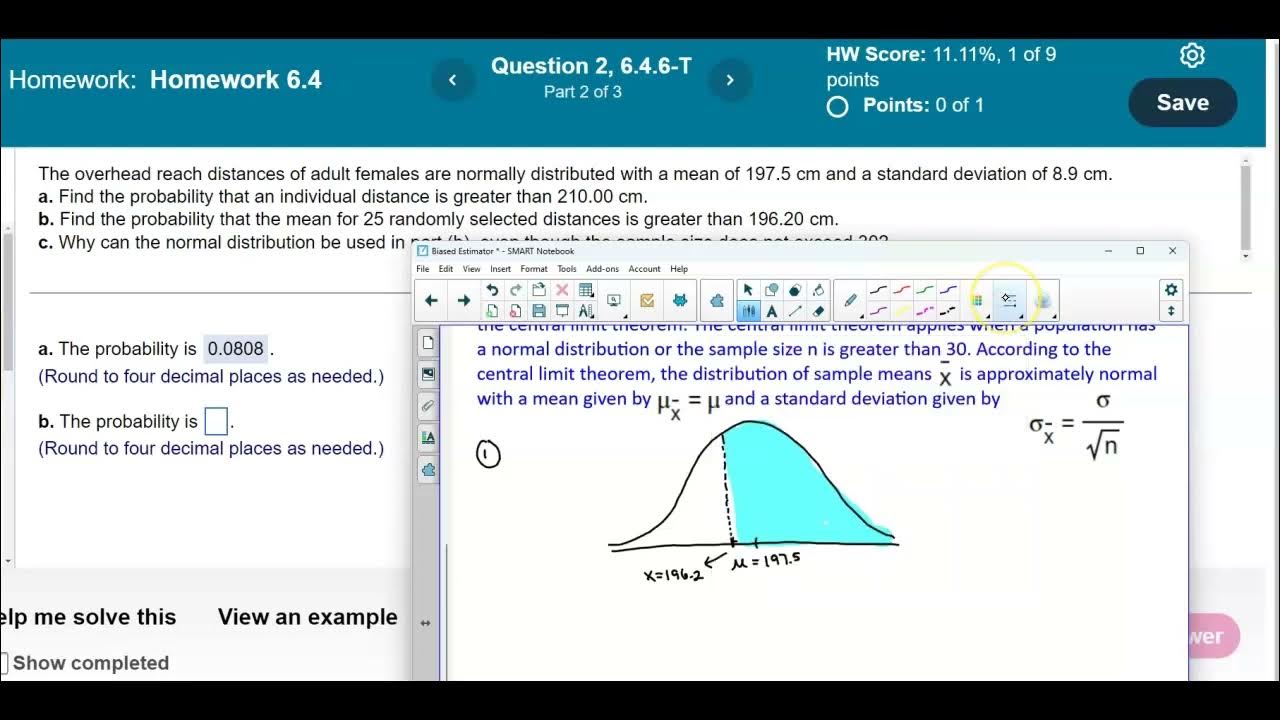Math 14 HW 6.4.11-T Using the Central Limit Theorem
TLDRThe script discusses the probability calculations for the mean weight of passengers on a water taxi. It starts by determining the maximum mean weight for a full capacity of 25 passengers, which is 150 pounds. Then, using the Central Limit Theorem, it calculates the probability that the mean weight exceeds this value when filled with 25 passengers, resulting in an extremely low probability due to a high z-score of -6.38. The script also explores a scenario with a revised capacity of 20 passengers and finds the probability of exceeding a mean weight of 187.5 pounds, which is higher at 93.45%, indicating the new capacity may not be safe.
Takeaways
- 🚤 The water taxi's load limit is 3750 pounds, with a stated capacity for 25 passengers.
- 📊 The passengers' weights are normally distributed with a mean of 201 pounds and a standard deviation of 40 pounds.
- 🔢 The maximum mean weight of passengers for the taxi to be filled to capacity without exceeding the load limit is calculated to be 150 pounds.
- 📚 According to the Central Limit Theorem, the sample means will follow a normal distribution with the given population mean and standard deviation.
- 📉 The probability of the mean weight of 25 randomly selected passengers exceeding 150 pounds is extremely low, with a z-score of -6.38 leading to a probability close to zero.
- 📈 The standard deviation of the sample means is calculated using the formula: population standard deviation divided by the square root of the sample size.
- 📝 The z-score is calculated by subtracting the mean of the sample means from a given value and dividing by the standard deviation of the sample means.
- 📉 The revised scenario with a capacity of 20 passengers and a maximum mean weight of 187.5 pounds for safety is analyzed.
- 🔍 A z-score of -1.51 is calculated for the new scenario, indicating a higher probability of the mean weight exceeding the safe limit compared to the initial scenario.
- 🤔 The probability of overloading with 20 passengers is over 50 percent, suggesting that the new capacity may not be safe enough.
- 📊 The use of StatCrunch software is demonstrated to find the probabilities associated with the z-scores in the scenarios.
Q & A
What is the stated capacity of the water taxi in terms of the number of passengers?
-The stated capacity of the water taxi is 25 passengers.
What is the maximum load limit of the water taxi in pounds?
-The water taxi is rated for a load limit of 3750 pounds.
What is the mean weight of the passengers according to the normal distribution?
-The mean weight of the passengers is 201 pounds.
What is the standard deviation of the passengers' weights?
-The standard deviation of the passengers' weights is 40 pounds.
What is the maximum mean weight of passengers if the water taxi is filled to its stated capacity?
-The maximum mean weight of passengers, if the water taxi is filled to its stated capacity of 25 passengers, is 150 pounds.
According to the Central Limit Theorem, what is the distribution of the sample means?
-According to the Central Limit Theorem, the sample means will have a normal distribution with the mean equal to the population mean and a standard deviation equal to the population standard deviation divided by the square root of the sample size (N).
What is the probability that the mean weight of 25 randomly selected passengers exceeds 150 pounds?
-The probability that the mean weight of 25 randomly selected passengers exceeds 150 pounds is extremely low, as indicated by a z-score calculation resulting in a probability of 0.000.
What is the z-score for a sample mean of 150 pounds with a population mean of 201 and a standard deviation of 40 pounds for a sample size of 25?
-The z-score for this scenario is approximately -6.38, indicating a value far below the mean of the sample means distribution.
If the water taxi's capacity is revised to 20 passengers, what is the new maximum mean weight that does not cause the total load to exceed 3750 pounds?
-With a revised capacity of 20 passengers, the new maximum mean weight that does not cause the total load to exceed 3750 pounds is 187.5 pounds.
What is the probability that the mean weight of 20 randomly selected passengers exceeds 187.5 pounds?
-The probability that the mean weight of 20 randomly selected passengers exceeds 187.5 pounds is approximately 93.45%, which is calculated using a z-score of -1.51.
Is the new capacity of 20 passengers considered safe based on the probability of overloading?
-No, the new capacity of 20 passengers is not considered safe, as the probability of overloading is over 50%, indicating a high risk of exceeding the load limit.
Outlines
🚤 Maximum Mean Weight Calculation for a Water Taxi
This paragraph discusses a scenario where a water taxi is carrying passengers with weights normally distributed around a mean of 201 pounds and a standard deviation of 40 pounds. The taxi has a capacity for 25 passengers and a load limit of 3750 pounds. The script calculates the maximum mean weight of passengers the taxi can carry without exceeding its load limit, which is found to be 150 pounds. It then explores the probability that the mean weight of 25 randomly selected passengers exceeds this maximum mean weight, using the central limit theorem to determine the sample mean's distribution. The z-score calculation for this scenario results in a value of -6.38, indicating an extremely low probability of the mean weight exceeding 150 pounds.
📊 Probability of Exceeding Mean Weight with Revised Capacity
The second paragraph delves into a hypothetical situation where the water taxi's capacity is revised to 20 passengers. The script calculates the new maximum mean weight that would not cause the total load to exceed 3750 pounds, which is 187.5 pounds. It then finds the z-score for this new scenario, resulting in -1.51, and uses it to determine the probability that the mean weight of 20 randomly selected passengers exceeds 187.5 pounds. The probability is found to be 0.9345, or 93.45%, indicating a high likelihood of the water taxi being overloaded if the mean weight of passengers is above this new maximum mean weight.
🚫 Assessing the Safety of the Revised Passenger Capacity
In the final paragraph, the script evaluates the safety of the revised capacity of 20 passengers. Given the high probability of overloading calculated in the previous paragraph, the script concludes that the new capacity does not appear to be safe enough, as there is a greater than 50% chance of the water taxi exceeding its load limit with a mean weight of passengers above the maximum allowed mean weight.
Mindmap
Keywords
💡Water Taxi
💡Normal Distribution
💡Mean Weight
💡Standard Deviation
💡Capacity
💡Load Limit
💡Central Limit Theorem
💡Sample Size
💡Z-Score
💡Probability
💡Overloading
Highlights
A water taxi's capacity and load limit are analyzed with a statistical approach.
Passenger weights are assumed to be normally distributed with a mean of 201 pounds and a standard deviation of 40 pounds.
The water taxi's stated capacity is 25 passengers and its load limit is 3750 pounds.
Calculation of the maximum mean weight of passengers if the water taxi is filled to its stated capacity.
Determination that the maximum mean weight is 150 pounds for the water taxi to operate within its load limit.
Application of the Central Limit Theorem to determine the distribution of sample means.
The sample mean's distribution has a mean equal to the population mean and a standard deviation dependent on sample size.
Graphical representation of the normal distribution to visualize the problem.
Calculation of the probability that the mean weight of 25 randomly selected passengers exceeds 150 pounds.
Use of the z-score formula to standardize the distribution and calculate probabilities.
A z-score of negative 6.38 indicates an extremely low probability of the mean weight exceeding 150 pounds.
Utilization of statistical software to find the probability associated with the z-score.
A probability of 1.000 suggests that it is virtually impossible for the mean weight to exceed 150 pounds with 25 passengers.
Revised assumptions for a new capacity of 20 passengers and the calculation of the corresponding maximum mean weight.
The new maximum mean weight is determined to be 187.5 pounds for a 20-passenger capacity.
Recalculation of the z-score for the new scenario with 20 passengers and a mean weight of 187.5 pounds.
A z-score of negative 1.51 for the new scenario indicates a significantly higher probability of exceeding the mean weight.
Statistical software is used again to find the probability of the new z-score, resulting in 0.9345.
Interpretation of the results suggests that the new 20-passenger capacity may not be safe due to a high probability of overloading.
Transcripts
Browse More Related Video

The Probability an Elevator is Overloaded Central Limit Theorem with StatCrunch

Math 14 HW 6.4.12-T Using the Central Limit Theorem

Calculating Probabilities of Sample Distributions with StatCrunch

Math 14 HW 6.4.6-T Using the Central Limit Theorem

Math 14 HW 6.4.12-T Using the Central Limit Theorem

Math 14 HW 6.4.15-T Using the Central Limit Theorem
5.0 / 5 (0 votes)
Thanks for rating: